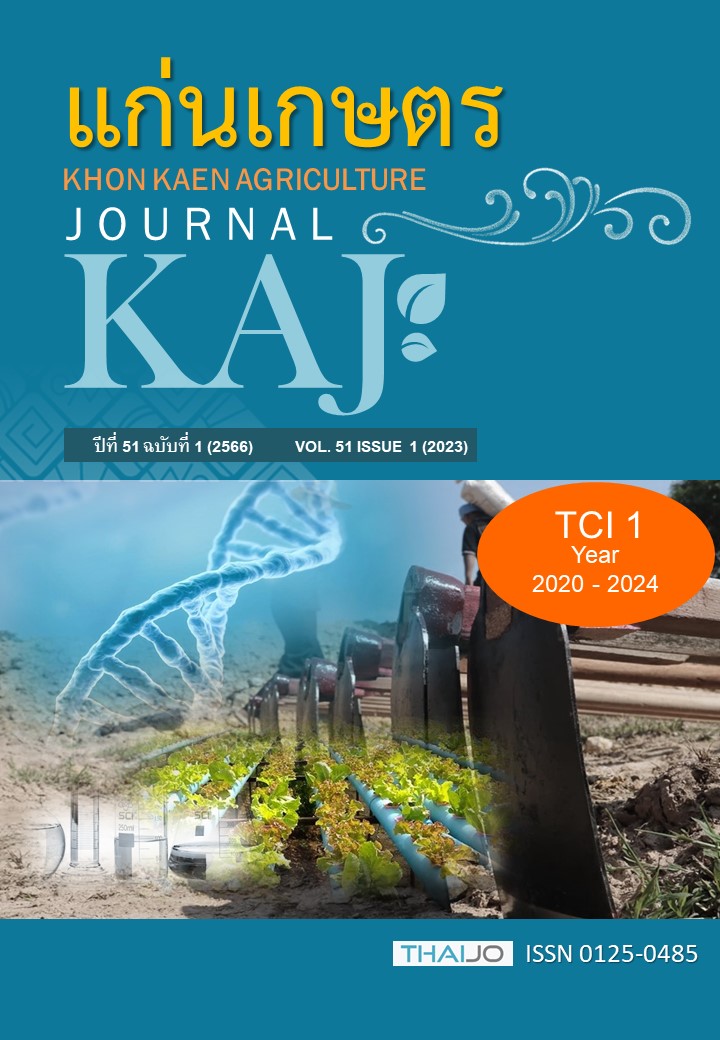อิทธิพลของการจัดการใบอ้อยที่ระยะเก็บเกี่ยวต่อการงอกและการแตกกอของอ้อยตอ
Main Article Content
บทคัดย่อ
เกษตรกรส่วนใหญ่มักเผาใบอ้อยในช่วงเก็บเกี่ยว เนื่องจากสามารถลดเวลาและแรงงานคนในการตัดได้ แต่การเผาอ้อยเป็นสาเหตุหนึ่งที่ทำให้เกิดฝุ่นละอองขนาดเล็กที่เป็นมลภาวะทางอากาศ ทำให้ดินสูญเสียความชุ่มชื้น ทำลายจุลินทรีย์ในดิน ส่งผลทำให้ดินเสื่อมโทรม ซึ่งอาจส่งผลถึงการงอกและเจริญเติบโตของอ้อยตอได้ ดังนั้นการศึกษาครั้งนี้มีวัตถุประสงค์เพื่อหาแนวทางการจัดการเศษซากใบอ้อยหลังการเก็บเกี่ยวที่เหมาะสมต่อการงอกและการแตกกอของอ้อยตอ ดำเนินการศึกษา ณ แปลงเกษตรกร อ.บ้านไผ่ จ.ขอนแก่น ใช้แผนการทดลองสุ่มสมบูรณ์ในบล็อก randomized complete block design (RCBD) จำนวน 4 ซ้ำ มี 3 กรรมวิธี ได้แก่ 1) เผาใบอ้อย 2) วางใบอ้อยคลุมแปลง และ 3) วางใบอ้อยคลุมแปลง ร่วมกับ พด.1 บันทึกข้อมูลการงอกของอ้อยที่ระยะ 2 เดือนหลังการจัดการเศษซากใบอ้อย ข้อมูลความสูงต้น เส้นผ่านศูนย์กลางลำ ค่าความเขียวเข้มของใบ และจำนวนลำต่อกอ ที่อายุ 4 6 8 และ 10 เดือน บันทึกน้ำหนักต่อลำที่อายุ 10 เดือน ผลการศึกษาพบว่าที่ระยะ 2 เดือนหลังการจัดการเศษซากใบอ้อย กรรมวิธีการเผาใบอ้อย มีจำนวนหน่อต่อกอสูงที่สุดอย่างมีนัยสำคัญยิ่งทางสถิติ (P<0.01) ส่วนความสูงต้น เส้นผ่านศูนย์กลางลำ และค่าความเขียวเข้มของใบ ไม่แตกต่างกันทางสถิติระหว่างทุกกรรมวิธีในทุกระยะการเจริญเติบโต นอกจากนี้กรรมวิธีการเผาใบอ้อยมีจำนวนลำต่อกอสูงที่สุด อย่างมีนัยสำคัญยิ่งทางสถิติ (P<0.01) ที่อายุ 4 เดือน ในขณะที่อ้อยอายุ 6 8 และ 10 เดือน กรรมวิธีการวางใบอ้อยคลุมแปลงร่วมกับ พด.1 มีจำนวนลำต่อกอสูงที่สุด อย่างมีนัยสำคัญยิ่งทางสถิติ (P<0.01) และส่งผลให้มีน้ำหนักต่อลำสูงที่สุด อย่างมีนัยสำคัญทางสถิติ (P<0.05) จากผลการวิจัยครั้งนี้สรุปได้ว่าการเผาใบอ้อยที่ระยะเก็บเกี่ยวทำให้อ้อยมีการงอกสูงที่สุด แต่เมื่อเข้าสู่ระยะแตกกอ ระยะสะสมน้ำตาล และระยะเก็บเกี่ยว พบว่า การวางเศษซากใบอ้อยร่วมกับ พด. 1 ทำให้อ้อยตอมีจำนวนลำต่อกอ และน้ำหนักต่อลำสูงที่สุด ดังนั้น การจัดการซากใบอ้อยที่ระยะเก็บเกี่ยว โดยการวางใบอ้อยร่วมกับ พด. 1 สามารถส่งเสริมการเจริญเติบโตและผลผลิตของอ้อยตอได้สูงสุด
Article Details

อนุญาตภายใต้เงื่อนไข Creative Commons Attribution-NonCommercial-NoDerivatives 4.0 International License.
เอกสารอ้างอิง
กรมพัฒนาที่ดิน. 2556. มหัศจรรย์ พด. กรมพัฒนาที่ดิน กระทรวงเกษตรและสหกรณ์. แหล่งข้อมูล: http://www.ldd.go.th/menu_5wonder/index.html. ค้นเมื่อ 14 ธันวาคม 2562.
ละอองดาว แสงหล้า และธวัชชัย ศุภดิษฐ์. 2548. ผลกระทบจากการเผาใบอ้อยและแนวทางการแก้ไข. แหล่งข้อมูล: http://naduang.loei.doae.go.th/Imager1/032556/do2.pdf. ค้นเมื่อ 16 มกราคม 2565.
วรรณวิภา แก้วประดิษฐ์. 2021. การจัดการใบอ้อยเพื่อลดฝุ่นละอองขนาดเล็กและส่งเสริมการผลิตอ้อยอย่างยั่งยืน. แก่นเกษตร. 49(1): 76-86.
วิชญ์ภาส อีสา และวรรณวิภา แก้วประดิษฐ์. 2563. การเปลี่ยนแปลงอินทรีย์คาร์บอนของดินส่วนที่เปลี่ยนแปลงได้ง่ายหลังได้รับการเก็บเกี่ยวอ้อยแบบไม่เผาใบ ภายใต้สภาพดินเหนียวที่ได้รับการเผาใบอย่างเนื่อง. วารสารเกษตรพระวรุณ. 17(1): 21-32.
สำนักงานคณะกรรมการอ้อยและน้ำตาลทราย. 2563. พื้นที่การปลูกอ้อย ปีการผลิต 2562/2563. แหล่งข้อมูล: http: //www.ocsb.go.th/th/home/index.php. ค้นเมื่อ 5 มีนาคม 2565.
สำนักงานเศรษฐกิจการเกษตร. 2564. รายละเอียดภาวะเศรษฐกิจการเกษตร. แหล่งข้อมูล:
https://www.oae.go.th/assets/portals/1/fileups/bappdata/files/Outlook%202564%20_2565%20(Final).pdf. ค้นเมื่อ 24 มกราคม 2565.
Bordonal, R.O., J.L.N. Carvalho, R. Lai, E.B. Figueiredo, B.G. Oliveira, and N.L.S Jr. 2018. Sustainability of sugarcane production in Brazil. A review. Agronomy for Sustainable Development. 38: 13.
Butphu, S., F. Rasche, G. Cadisch, and W. Kaewpradit. 2020. Eucalyptus biochar application enhances Ca
uptake of upland rice, soil available P, exchangeable K, yield, and N use efficiency of sugarcane in a crop rotation system. Journal of Plant Nutrition and Soil Science. 183: 58-68.
Cherubin, M.R., R.O. Bordonal, G.A. Castioni, E.M. Guimarães, I.P. Lisboa, L.A.A. Moraes, L.M.S Menandro, S. Tenelli, C.E.P. Cerri, D.L. Karlen, and J.L.N. Carvalho. 2021. Soil health response to sugarcane straw removal in Brazil. Industrial Crops and Products. 163: 1-12.
de Oliveira, A.P.P., P.J. Thorburn, J.S. Biggs, E. Lima, L.H.C.D. Anjos, M.G. Pereira, and N.É. Zanotti. 2016. The response of sugarcane to trash retention and nitrogen in the Brazilian coastal tablelands: a simulation study. Experimental Agriculture. 52(1): 69-86.
Dietrich, G., M. Sauvadet, S. Recous, M. Redin, I.C. Pfeifer, C.M. Garlet, H. Bazzo, and S.J. Giacomini. 2017.
Sugarcane mulch C and N dynamics during decomposition under different rates of trash removal. Agriculture, Ecosystems and Environment. 243: 123-131.
Fortes, C., P.O.C. Trivelin, and A.C. Vitti. 2012. Long-term decomposition of sugarcane harvest residues in Sao Paulo state, Brazil. Biomass and Bioenergy. 42: 189-198.
Hemwong, S., B. Toomsan, G. Cadisch, V. Limpinuntana, P. Vityakon, and A. Patanothai. 2009. Sugarcane
residue management and grain legume crop effects on N dynamics, N losses and growth of sugarcane. Nutrient Cycling in Agroecosystems. 83: 135-151.
Hemwong, S., G. Cadish, B. Toomsan, V. Limpinuntana, P. Vityakon, and A. Patanothai. 2008. Dynamics
of residue decomposition and N2 fixation of legumes upon sugarcane stover retention as an alternative to burning. Soil and Tillage Research. 99: 84-97.
Meier, E.A., and P.J. Thorburn. 2016. Long term sugarcane crop residue retention offers limited potential to reduce nitrogen fertilizer rates in Australian wet tropical environments. Frontiers in Plant Science. 7: 1-14.
Meier, E.A., P.J. Thorburn, M.K. Wegener, and K.E. Basford. 2006. The availability of nitrogen from
sugarcane trash on contrasting soil in the wet tropics of North Queensland. Nutrient Cycling in Agroecosystems. 75: 101-114.
Oliveira, M.W., P.C.O. Trivelin, G. Kingston, M.H.P. Barbosa, and A.C. Vitti. 2002. Decomposition and release of nutrients from sugarcane trash in two agriculture environment in Brazil. P. 1-10. In: conference of the Australian society of sugarcane technologists. Cairn.
Phukongchai, W., W. Kaewpradit, and F. Rasche. 2022. Inoculation of cellulolytic and ligninolytic microorganisms accelerates decomposition of high C/N and cellulose rich sugarcane straw in tropical sandy soils. Applied Soil Ecology. 172: 104355.
Prammanee, P. 2001. Fertilizer usage and soil management in sugarcane field. Bangkok: Department of Agriculture, Ministry of Agriculture and Co-operatives. (in Thai).
Russell, J.D., A.R. Fraser, J.R. Watson, and J.W. Parsons. 1974. Thermal decomposition of protein in soil
organic matter. Geoderma. 11: 63-66.
Schloter, M., O. Dilly, and J.C. Munch. 2003. Indicators for evaluating soil quality. Agriculture Ecosystem and Environment. 98: 255-262.
Souza, R.A., T.S. Telles, W. Machado, M. Hungri, J.T. Filho, and M.F. Guimaraes. 2012. Effect of sugarcane harvesting with burning on the chemical and microbiological properties of the soil. Agriculture, Ecosystems and Environment. 155: 1-6.
Surendran, U., V. Ramesh, M. Jayakumar, S. Marimuthu, and G. Sridevi. 2016. Improved sugarcane productivity with tillage and trash management practices in semi arid tropical agro ecosystem in India. Soil and Tillage Research. 158: 10-21.
Thawaro, N., B. Toomsan, and W. Kaewpradit. 2017. Sweet sorghum and upland rice: alternative
preceding crops to ameliorate ethanol production and soil sustainability within the sugarcane cropping system. Sugar Tech. 19(1): 64-71.
Yadav, R.L., S.K. Shukla, A. Suman, and P.N. Singh. 2009. Trichoderma inoculation and trash management effects on soil microbial biomass, soil respiration, nutrient uptake and yield of ratoon sugarcane under subtropical conditions. Biology and Fertility of Soils. 45: 461-468.


